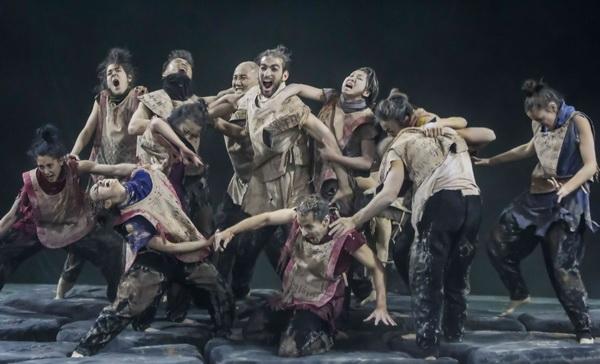The Estede of Spring was named the first of the 50 works with the greatest influence on the history of Western music by the British classical music magazine Classical cd magazine, and its musical power is strange, violent, and unrestrained, attracting generations of choreographers to approach it, deconstruct it, and choreograph it.
This subversive work in the history of music also had a profound impact on the Portuguese choreographer Daniel Cassel. When dancing with the American Martha Graham Modern Dance Company, "The Estede of Spring" was Cassel's first work, and he couldn't stop wanting it ever since, and the idea of bringing it to the stage was also deeply rooted in his heart.
On January 24, at the Shanghai Oriental Art Center, "The Ested Year of Spring", rehearsed by Daniel Cassel and led by the Portuguese Cullen Dance Company, will usher in its world premiere. Interestingly, this is a "Spring Festival" with a strong "Chinese color" and thinking from the chinese soil.

"Spring in Russia is fierce and violent, and in an hour spring arrives, and it is menacing, and the earth seems to be shattered by it." In 1910, the Russian composer Stravinsky, who was about to finish Firebird, saw in his sleep a pagan ritual in which the elders sat on the floor and saw a young girl dancing to death, and they wanted to sacrifice her to appease the god of spring.
This is the image of the ancestor worship ritual of the ancient Russian tribes in Stravinsky's fantasy. In 1913, he composed this imagination into the symphonic music "The Rite of Spring", which was choreographed into a ballet by the hand of nijinsky, the "god of dance".
The premiere of "The Charity of Spring" in Paris caused a sensation, and the sacrificed and sacrificed maidens also became the symbol of the "Charity of Spring". However, in Cassel's arrangement, the object of sacrifice becomes a man, and the sacrifice of the individual is transformed into a collective sacrifice.
Cassel's The Rite of Spring connects the concept of sacrifice to a contemporary context, where all dancers dance to the death and are sacrificed, "Each will be sacrificed as a collective."
This version of "The Rite of Spring" lasts 75 minutes and is divided into three parts: the first part, "Blank", like a blank drawing board, guides the dancers into the creative process; the second part is "Chinese Elements", which is divided into four sections: relationship, yin and yang, nature, and mythology; the third part truly enters the "Spring Festival", and the power of the first two parts accumulates here, leading to the final collective sacrifice.
As early as two years ago, when preparing "The Duty of Spring", Cassel decided to create a dance with Chinese colors and Chinese elements. To this end, he successively went to the mountains of Yunnan, Lhasa, Tibet, and Xi'an, Shaanxi to collect wind, and the original ecological songs in the mountains of Yunnan and the singing scriptures of Tibetan lamas stimulated him greatly, and the Terracotta Warriors and Horses of Qin Shi Huang had a decisive influence on his creation.
The inspiration for the third part of this edition of the Rite of Spring is the Terracotta Warriors. At the climax, the dancers apply dirt to their bodies, like clay sculptures, unfolding the process of pouring the terracotta warriors step by step, and then the armor falls from the sky, and the dancers who wear the armor finally dance to death.
Cassel put the idea of sacrifice on a group of warriors. In his view, sacrifice is an eternal topic, the war is endless, the soldiers go forward and follow, the sacrifice is inevitable, and it can never be extinct - the terracotta warriors who still stand in the mausoleum of Qin Shi Huang today are not the symbols of this kind of collective sacrifice?
"The music of 'The Rite of Spring' is extremely complex, and the Terracotta Warriors deserve this musical power." Cassel specifically explained that this version of the "Rite of Spring" did not use Stravinsky's music until the third part, and the music of the first two parts was originally written by the Portuguese composer Jog Silva.
In addition to Chinese elements, Cassel also invited Chinese choreographer Xie Xin, as well as 7 Chinese dancers to join - Xie Xin is a rising star in the modern Chinese dance world, in the second part of "Spring Festival", she is responsible for the choreography of "relationship", "yin and yang" and "nature" three dances with Chinese elements.
"This is the "Spring Festival" that I thought out from the chinese soil. The participation of the Chinese creative staff made the whole project icing on the cake, without them, there would be no birth of this "Spring Festival". Cassel said.
After the Shanghai premiere, Cassel will also take "Spring Festival" to Wuhan, Changsha, Zhuzhou tour, and return to his hometown portugal in April this year. He is not worried that European audiences will not be able to understand these Chinese colors and Chinese elements, on the contrary, when he interprets China with the perspective of Europeans, he hits the fate of their most interested.
Daniel Casso